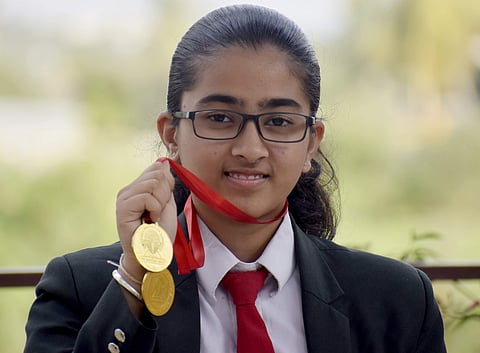

Meet Nidhi Mayurika, a class IX student studying at Narayana Olympiad School in Bengaluru who, with her incredible innovations like a three-layered space colony and a satellite to launch another satellite, has been winning the NASA Ames Space Settlement Contest for three years now. She is full of energy and the sky is the limit for her imagination and calculations. While many of us have to open the dictionary to search for the meaning of space-related terminology, she has all of them on the tip of her tongue. After so much of groundwork about space and its elements, she aims to become a cosmologist and represent India on an international platform.
When Nidhi was 11, she felt that the creation of the universe was a strange phenomenon and this curiosity led her to find out and learn more about it. She says, "When I was in class V, I’d always take part in the science competitions held at the school level. Considering my interest, my school principal told me about the NASA Ames Space Settlement Contest. I had two reasons for participating in this contest. Firstly, this was a platform for me to express myself, my ideas about space and its elements. The other reason is that I wanted to represent my country. After all, we Indians have been able to prove many theories with the power of imagination alone like the Theory of Parmanu(atom), solar systems and many more."
In 2016, when the organisers of the NASA contest announced that the students must design something on the lines of the virtual space colonies in which settlers can live inside a gigantic spacecraft, Nidhi spent more than two hours a day, after school, working on a project called Saikatam — which translates to a new home away from home. "Saikatam is a three-layered space colony for human settlement at Earth-Moon Lagrange Point 5 situated at 3,85,000 km. It is a space colony for humans to survive, evolve and self-sustain. The space colony is akin to Earth with life gases, artificial gravity, water, and food," she explains.
Needless to say, Nidhi’s efforts and the time she spent paid off. She won the first prize for Saikatam. In the 2017 NASA contest, she participated again and her project bagged the first prize again. This time it was for the project Soham, which is used to launch satellites. She says, "Soham is a habitable space colony located 350 km away from Earth at LEO, to build and launch satellites, comprising of an Inflatable Space Station."
Nidhi’s third project, which she presented this year, was Swastikam — a place for creation. "Swastikam is a space colony built for synthetically designed and created organisms to adapt, evolve and be independent in the new ecosystem. This helps organisms adapt to change in conditions such as radiation, heat, continuous daylight and lack of gravity," she explains patiently.
It is not just the books and the hours Nidhi spent after school that has helped her come this far at such a young age. She has taken up online programmes relating to the universe from The University of Edinburgh, the Australian National University, Boston University and many more. She says, "The lectures gave me a lot of information, helped me with innovative ideas about space colonies and also gave me problem statements to do the project every year."
With Nidhi's innovations, it feels like India will have its youngest cosmologist by 2020 and who knows, we might even create an artificial place to live in space — designed by a girl from namma Bengaluru!
